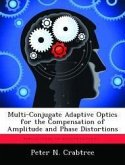Thermal blooming can have a major impact on high-energy laser (HEL) beam propagation in the atmosphere. In theory, an adaptiveoptics (AO) system can mitigate the nonlinear optical effects induced by thermal blooming; however, when a single deformable mirror is used for phase-only compensation, analysis predicts the possibility of instability. This instability is appropriately termed phase compensation instability (PCI) and arises with the time-dependent development of spatial perturbations found within the HEL beam. These spatial perturbations act as local hot spots that produce negative-lens-like optical effects in the atmosphere. An AO system corrects for the hot spots by applying positive-lens-like phase compensations. In turn, this increases the strength of the thermal blooming and leads to a runaway condition, i.e. positive feedback in the AO control loop. This study uses a series of computational wave-optics experiments to explore the conditions for insipient PCI. Horizontal propagation is modeled with the effects of extinction, thermal blooming, and turbulence for a focused Gaussian beam. In addition, a nominal AO system is used for phase compensation from a point source beacon. Results show that the development of branch points under strong thermal blooming reduces the possibility of PCI.








